
June 10, 2008

The “Long-Tailed Wildcat” trapped and killed on January 16, 1922, in the Tinicum Swamp, Pennsylvania. Archival photograph, Henry W. Shoemaker, via Chad Arment.
Perhaps it would be good to take a bit of a look at the reports of long-tailed spotted and striped small mystery and not-so-mysterious cats, in light of yesterday’s mention of “Long-Tailed Bobcats.”
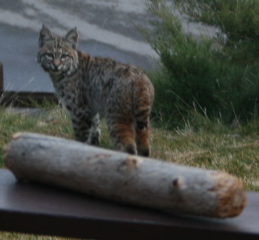
The bobcat pictured above has a short tail, but the photo shows how an allusion is created by the image of the tail merging with a back leg.
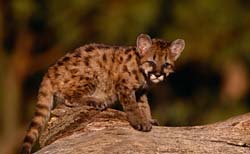
Puma, young.

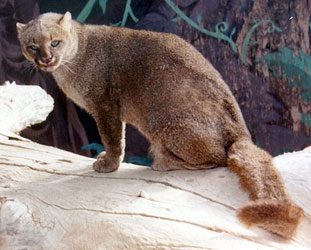
Are there any jaguarundis (Puma yaguarondi) in the mix?
Cryptozoologist Chad Arment has reminded me that the traditions, reports, and records of “Long-Tailed Wildcats” and “Long-tailed Bobcats,” especially in his native Pennsylvania, are elements of the cryptozoological research issuing from that state. These cats are often conceptualized in the literature in terms of being a cat identified as quite similar to the European wildcat or a feral domestic cat reverted to the wild-type mackeral tabby markings more than “long-tailed bobcats.” Arment has done a great job of tracking, collecting, and republishing these archives and reports in recent years.
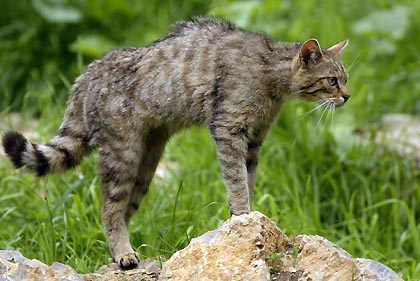
The European wildcat, Felis silvestris silvestris, above and below.

Arment’s book Cryptozoology: Science and Speculation (Coachwhip, 2004) has devoted an entire chapter, nine, to the issue, “Long-Tailed Wildcats.” Reproduced there, especially, are the observations of folklorist and wild animal story collector Henry W. Shoemaker. Shoemaker personally felt the felids being found, as described, in Pennsylvania, were examples of a unverified population of “Felis catus” or wild type of cat not dissimilar to the Scottish and European wildcats (Felis silvestris silvestris), which lived alongside puma and bobcat in his state, certainly in bygone days.

Arment has published online, as well, from BioFortean Review, (November 2006, No. 1), his “An Additional Account of an Alleged ‘Long-tailed Wild Cat'” about a newer case of a “wild cat” killed in 1966, near Grafton, Ohio.
Meanwhille, from the western USA, to add a bit of confusion to the picture, comes the stories and the “legendary” status of a new breed of domestic cat called the “Pixie-Bob”:
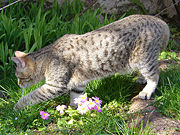
The Pixie-Bob (above) is a breed of cat claimed by breed founder Carol Ann Brewers to be a progeny of naturally occurring Bobcat hybrids . Later DNA testing failed to detect Bobcat marker genes and these cats are considered wholly domestic for the purposes of ownership, cat fancy registration, import and export.
In the spring of 1985 , Carol Ann Brewer purchased a polydactyl spotted male kitten from the base of Mount Baker (Washington State – Cascade Range). This male had a short tail like a Bob cat. In January of 1986 , she rescued another male cat. This cat was very large and had a bobcat tail. While this cat was starving, it still weighed 17 pounds, and was so tall it reached up to Brewer’s knees. Shortly after she had acquired this large male, it mated with a wild looking brown spotted female cat next door. In April of 1986 a litter was born from this mating. Brewer eventually kept one of the kitten, named “Pixie”, and after a year started a breeding program with Pixie as the foundation cat. Over the next couple of years, Brewer introduced into the program 23 cats from around the Cascade Mountains area that were believed to be born from naturally occurring matings between the Bobcat and domestic cat. She coined the term “Legend Cat” to refer to such cats.
The Pixie-bob was accepted into the “Exhibition” category by The International Cat Association (TICA) in 1993, promoted to “New Breed and Color” status in 1996 and eventually gained Championship status in 1998….
In 1996, DNA testing by Stormant Labs in California determined that Pixie-Bobs are genetically distinct and not related to other breeds. Wikipedia.
Great bewilderment can occur among the general public, in the realm of cryptid cats, and it’s not because there is a bit of “wild” in the middle of it all.
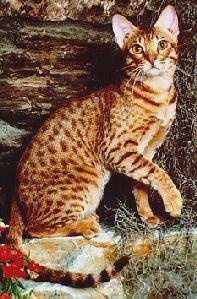
For example, a reported “wild ocelot (Leopardus pardalis) stalking a child in an American trailer park” turned out to be a pet Ocicat (pictured directly above and below), a breed with no wild genetic makeup at all. Despite its appearance, there is no “wild” DNA in the Ocicat’s gene pool. The species is actually a mixture of Siamese and Abyssinian, and later American Shorthairs (silver tabbies) that were added to the mix and gave the breed their silver color, bone structure and distinct markings.
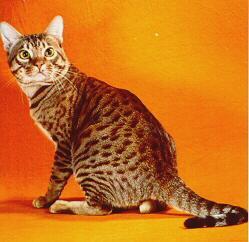
Phenotype is not always a reflection of genotype.
About Loren Coleman
Loren Coleman is one of the world’s leading cryptozoologists, some say “the” leading living cryptozoologist. Certainly, he is acknowledged as the current living American researcher and writer who has most popularized cryptozoology in the late 20th and early 21st centuries.
Starting his fieldwork and investigations in 1960, after traveling and trekking extensively in pursuit of cryptozoological mysteries, Coleman began writing to share his experiences in 1969. An honorary member of Ivan T. Sanderson’s Society for the Investigation of the Unexplained in the 1970s, Coleman has been bestowed with similar honorary memberships of the North Idaho College Cryptozoology Club in 1983, and in subsequent years, that of the British Columbia Scientific Cryptozoology Club, CryptoSafari International, and other international organizations. He was also a Life Member and Benefactor of the International Society of Cryptozoology (now-defunct).
Loren Coleman’s daily blog, as a member of the Cryptomundo Team, served as an ongoing avenue of communication for the ever-growing body of cryptozoo news from 2005 through 2013. He returned as an infrequent contributor beginning Halloween week of 2015.
Coleman is the founder in 2003, and current director of the International Cryptozoology Museum in Portland, Maine.
Filed under Alien Big Cats, Books, Breaking News, Cryptomundo Exclusive, Cryptotourism, CryptoZoo News, Cryptozoologists, Cryptozoology, Mystery Cats, Photos